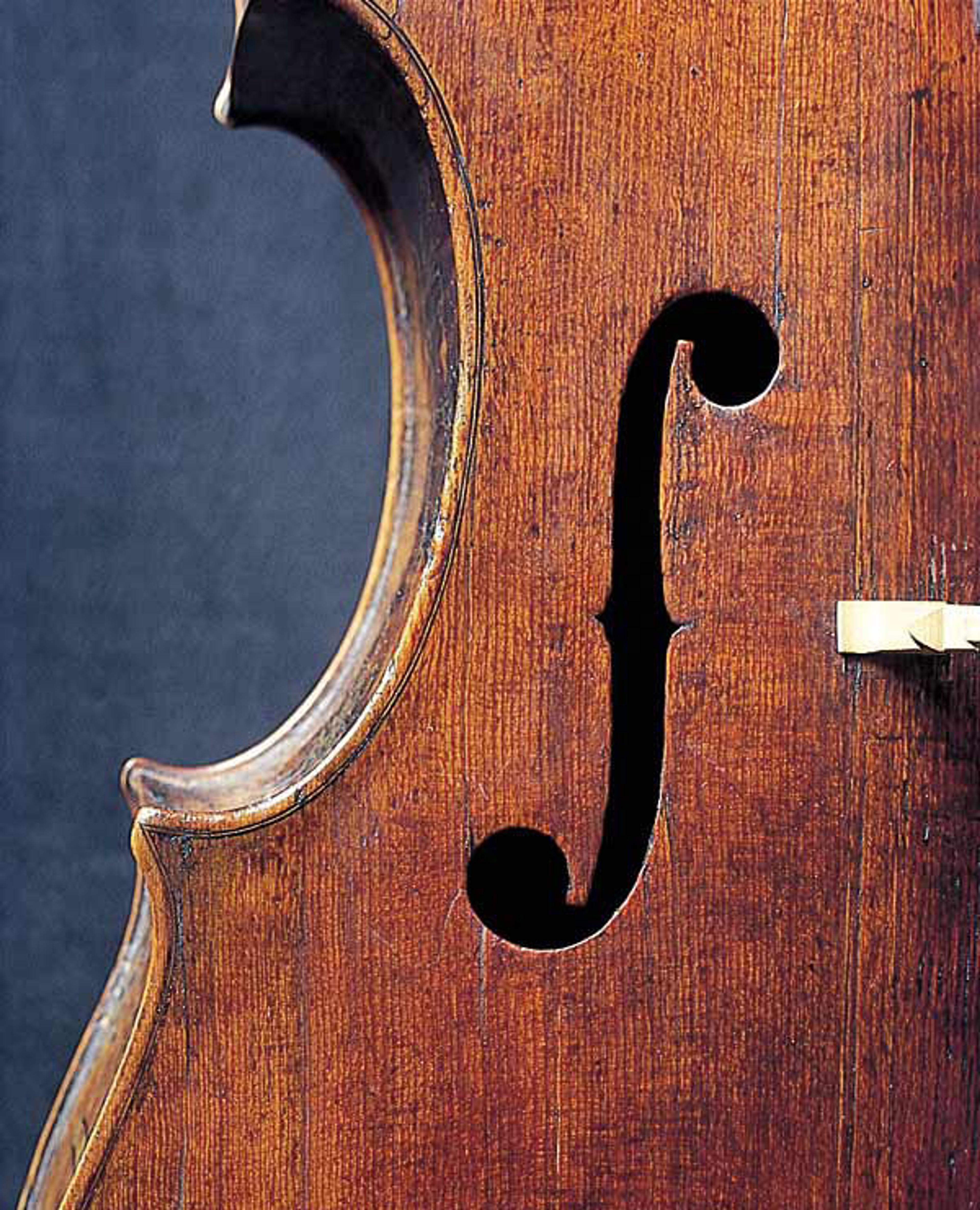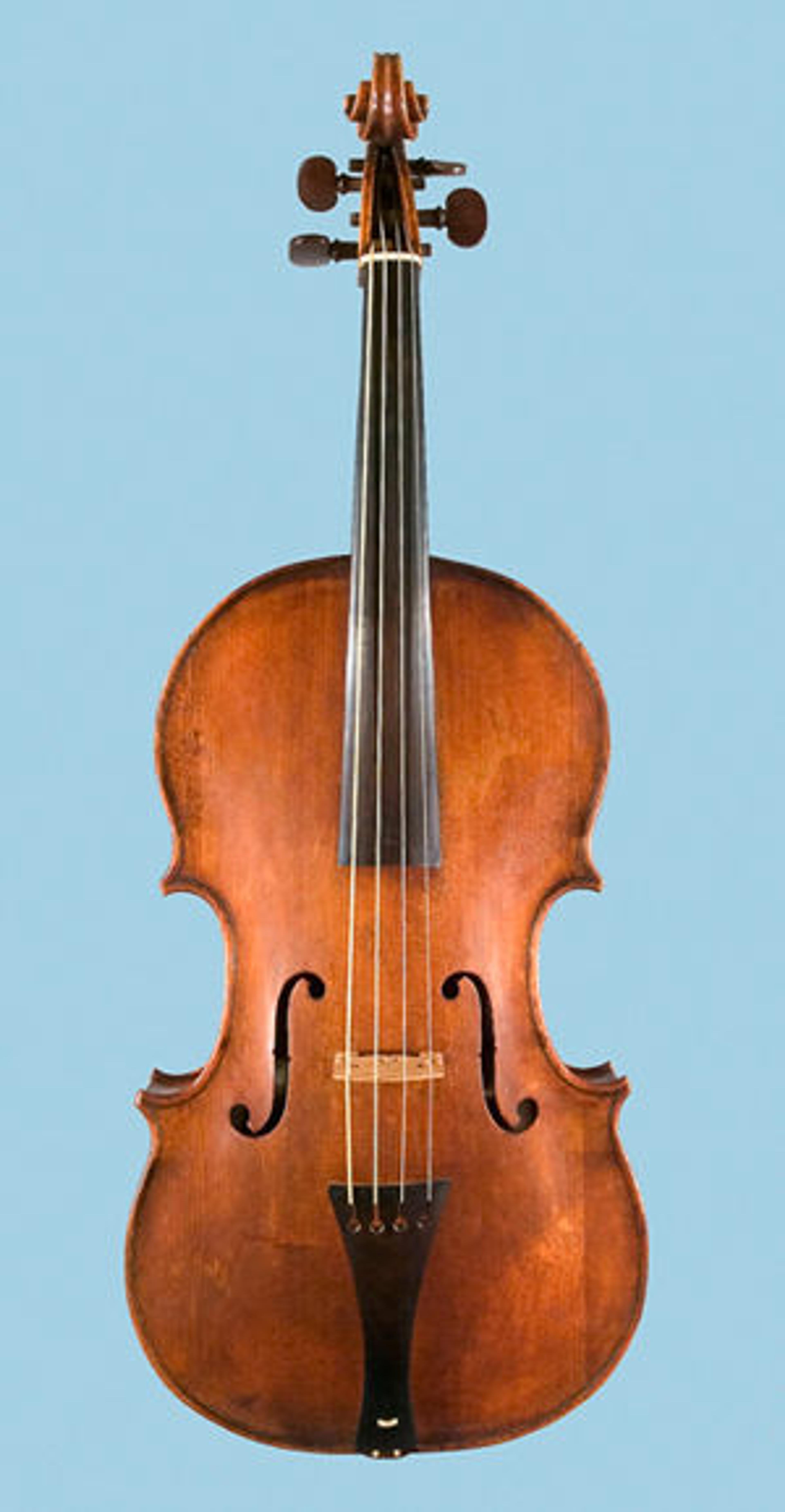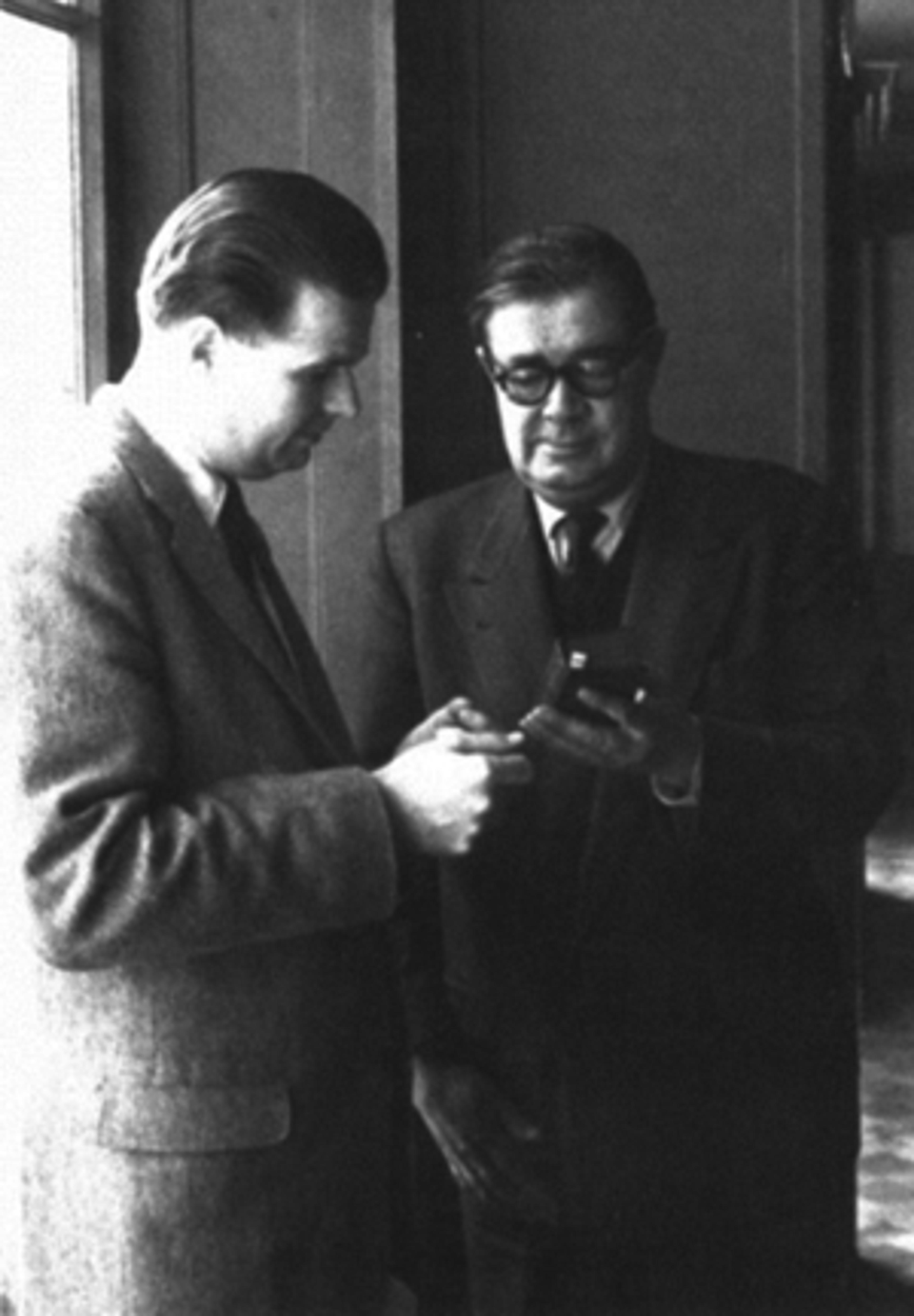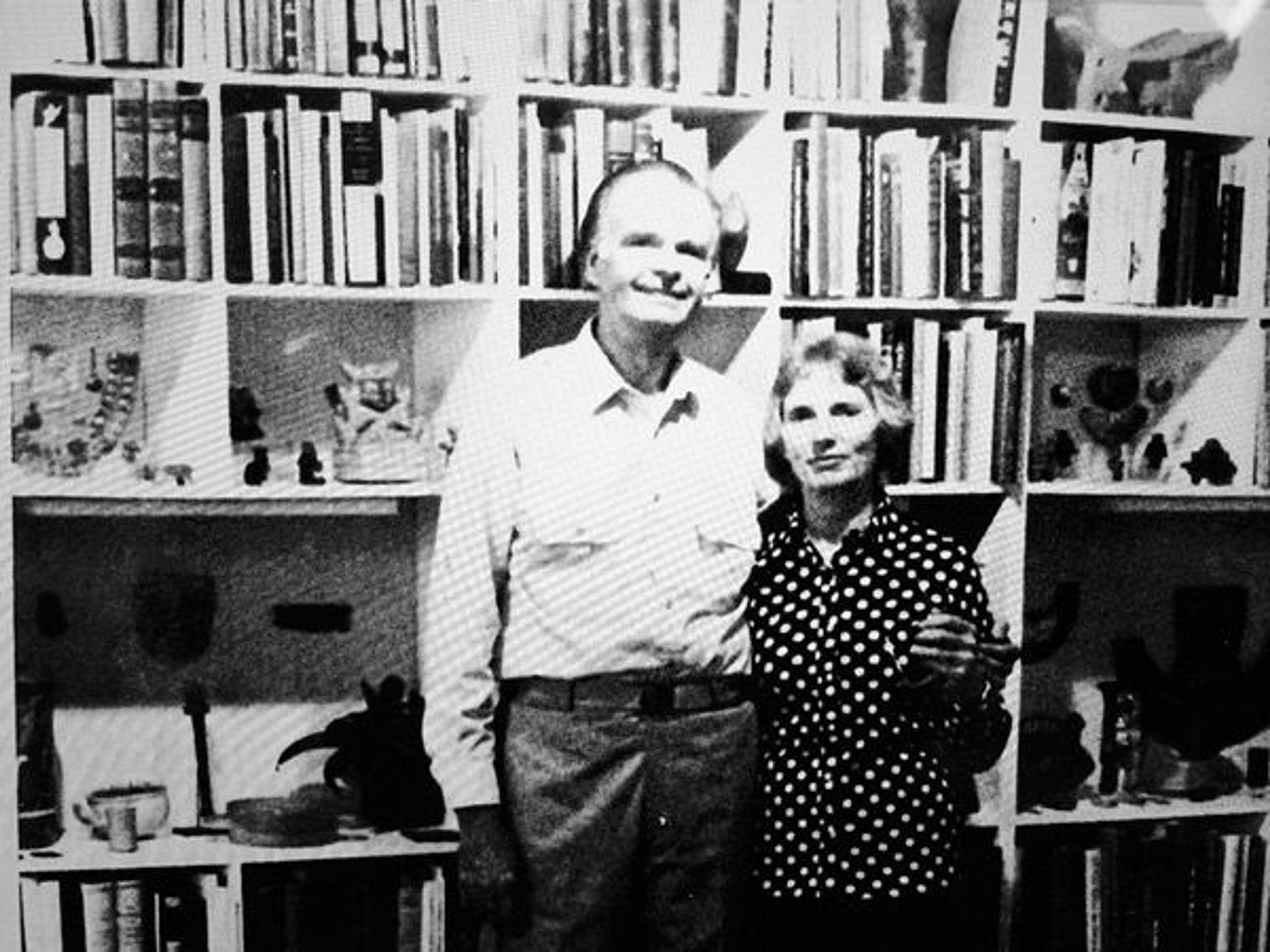
Andrea Amati (Italian, ca. 1505–1578). Violoncello, "The King" (detail), mid-16th century. National Music Museum, Vermillion, South Dakota, Witten-Rawlins Collection, 1984 (NMM 3351)
«The National Music Museum, located on the campus of the University of South Dakota, is home to the Andrea Amati cello known as the "King," on loan to the Metropolitan Museum through September 8. The instrument was acquired in 1984 by the then-director of the museum, Dr. André Larson, as part of the extensive collection of Laurence Witten (1926–1995). The purchase of this collection and its display were made possible by Robert and Marjorie Rawlins, alumni of the university, and as such, this collection is now referred to as "The Witten-Rawlins Collection of Stringed Instruments."»
Although the "King" cello is the outstanding jewel of the collection, it was accompanied by two other original, untouched Cremonese instruments: a 1667 tenor viola by Andrea Guarneri, and a 1613 violono piccolo made by Girolamo Amati. Also included in the Witten collection were three instruments in untouched condition that were discovered during the 1937 Cremona Bicentennial that marked the two hundredth anniversary of Antonio Stradivari's death—a 1793 viola by Pietro Giovanni Mantegazza of Milan, a 1792 violin by Marco Antonio Cerin of Venice, and a 1788 violin by Antonio Gragnani of Livorno—as well as seventy other stringed instruments and their bows.
Left: Andrea Guarneri (Italian, ca. 1626–1698). Tenor viola, 1664. National Music Museum, Vermillion, South Dakota, Witten-Rawlins Collection, 1984

Laurence Witten was one of the greatest collectors of important historical artifacts during the late twentieth century, and the musical world is indebted to him for both his grand view of history and the acute precision of his choice of instruments, which illustrate the early history of the violin family and its roots in northern Italy. Witten has been referred to as an "ideal collector" because he did not purchase by happenstance or whim, but assembled the collection with a clear ideal in mind: "to assemble a collection of the earliest, best preserved, and historically most important bowed stringed instruments known to survive in order to trace more systematically the early history of violin making in the chief Italian centers."
Witten purchased from some of the best experts in the field of musical instruments, including Emil Herrmann, Jacques Francais, Rembert Wurlitzer, Charles Beare, and the Bisiach family of Milan. Notwithstanding this aid, his expertise in early printed books and manuscripts furnished an accurate historical background for his personal appraisal and purchases of the finest examples of Italian lutherie. This, among his many talents, gave him an unfailing eye for provenance, authenticity, and accuracy in the examples that he chose.
Laurence Witten was born in 1926, in Cincinnati, to a life of relative privilege. His family was from Virginia and had done well in the tobacco and furniture-manufacturing businesses. He began studying the violin at the early age of six or seven, and as a boy he delighted in talking to performers about their violins. Witten "haunted" the Rudolph Wurlitzer Company in Cincinnati, where he bought his first fine bow when he was fourteen. At the age of sixteen he met Rembert Wurlitzer in New York City and purchased his first serious instrument, a 1776 violin by Andreas Kempter of Dillingen. He and Rembert developed a special bond over the years, perhaps because they were both Cincinnati natives, and Rembert guided Witten through his formative years as a violin collector.
Right: Laurence Witten (left) and fellow antiquarian book dealer Nicholas Rauch. Photo courtesy of the National Music Museum, Witten Archives

Witten graduated from Yale in 1951 with a bachelor's degree in Music, and in the same year opened his business, Laurence Witten Rare Books. His expertise in the world of books was renowned, and his specialty in early Venetian books and graphics led him to discover tantalizing evidence of the origins of the violin family in the Lira da Braccio. This literary graphic evidence was the seed that eventually evolved into his collecting actual examples of these artifacts in as near original condition as possible, and led to his publication of a seminal work on the history of the violin in volume one of the Journal of the American Musical Instrument Society, printed in 1975.
Witten's first serious attempts at forming a collection of musical instruments began in the 1960s, after he had already formed collections of Precolombian art, antique automobiles, and early sound recordings. He was inspired to formulate his ideal collection by the Hill Collection at the Ashmolean Museum in Oxford, England, the Heyer Collection in Leipzig, Germany, and the Archduke Ferdinand of Tyrol's personal collection now housed in the Kunsthistoriches Museum in Vienna, Austria. Witten's collection provided evidence that Andrea Amati, who worked during the first half of the sixteenth century, was the earliest originator of the violin—as well as other stringed instruments such as the "King" that were made for the French royal court.
Witten made his first purchases, in 1960, from Jacques Francais, followed by acquisitions from Emil Herrmann's private collection, in 1962. In 1967 he purchased the "King" cello from Rembert Wurlitzer, which had been owned previously by the Del Prieto family and was the first of three Andrea Amati decorated instruments that Witten would acquire.
He continued to collect through the 1970s and early 1980s, taking advantage of the sale of some of the great collections from the Bisiach family and Lord Astor's estate. In November 1983, after twenty-three years of forming his collection, Witten decided to place it on the market. He had recently had a heart attack and wanted to find a place where his collection could remain intact, preferably within the United States. On Valentine's Day in 1984, Witten issued a statement indicating that the collection had been sold to the National Music Museum in Vermillion, and that "all inquiries concerning the collection or individual items in it should be addressed to Dr. Larson."

Laurence and Cora Witten in 1984, shortly before his collection traveled to the National Music Museum. Photo courtesy of the National Music Museum, Witten Archives